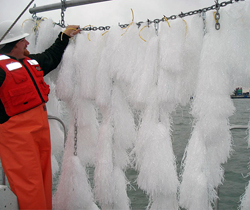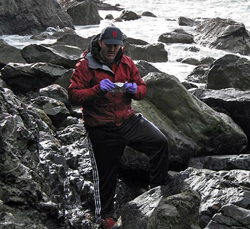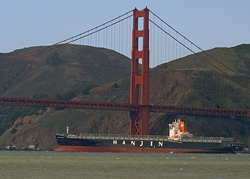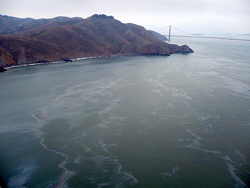Environmental assessment teams increasingly may be using a method to assess oil spill contamination in situations where it doesn't work well and are in danger of reaching false conclusions, a scientist at Woods Hole Oceanographic Institution has warned In a letter published online April 30 in the Marine Pollution Bulletin, marine chemist Christopher Reddy issued what he called “a cautionary tale” about using the “pom-pom” method as a universal practice for assessing oil contamination in ocean- or river-bottom sediments. The method uses long strands of absorbent polypropylene swabs, which look like cheerleaders’ pom-poms, dragged along bottom sediments. The method is in demand because it offers a rapid, low-cost way to locate large areas where oil has sunk to the sediments. But that doesn’t mean it can effectively identify lesser amounts of oil that can have harmful impacts on ecosystems and public health, Reddy said. Reddy pointed to the spill of 58,000 gallons of heavy fuel oil after the M/V Cosco Busan struck the San Francisco-Oakland Bay Bridge in November 2007. In late December, the pom-pom method was used to assess whether sediments dredged near the Port of Oakland could be safely used to help restore a tidal wetlands. “The problem may stem from an unfortunate misinterpretation of research following a spill of the M/T Athos I in the Delaware River in 2004,” Reddy wrote. In that case, responders used a boat to drag several beams with pom-poms across sediments on the riverbed. Back on deck, personnel could see whether the pom-poms came up white and clean or black and oil-stained and could quickly determine the locations of large oil patches on the river floor. The information proved valuable for putting together the best emergency response and cleanup, Reddy said. “But the method was never intended to assess contamination at much lower, but still significant levels,” Reddy wrote. “A great tool for the circumstances of the Delaware River oil spill does not translate to the conditions in San Francisco Bay.” In the Port of Oakland, the U.S. Army Corps of Engineers used the pom-pom method to look for evidence of tar balls that may have sunk to the sediments after the M/V Cosco Busan spill. Finding none, the Corps declared the dredged material safe and used it in the restoration project. “This approach is flawed,” Reddy wrote. “It relies on the assumption that the lack of visible oil on the (pom-poms) … indicates a total lack of oil contamination in the sediment.” Without any detailed testing to determine the pom-pom method’s ability and sensitivity to attract oil under various conditions and circumstances, “it is not possible to determine that the (Port of Oakland) sediment was not contaminated with oil at unacceptable levels,” Reddy said in an interview. “The absence of evidence is not evidence of absence.” “Before this approach becomes standard practice for determining whether sediments have been contaminated at levels that may impact ecosystems, prudence dictates much more rigorous testing of the test itself,” Reddy wrote in Marine Pollution Bulletin. “When considering analytical methods used following any oil spill, the selectivity and sensitivity should match the objectives and required information.” In a reply to Reddy article in Marine Pollution Bulletin, Robert Lawrence, chief of dredged material management for the Army Corps’s San Francisco District, acknowledged that Reddy is correct that “the (pom-pom) test is not meant to be looking for low levels of contaminants." “It’s meant for gross contamination,” Lawrence said. “The swabbing test needs to be tested further if it is to be incorporated as a be-all” used to assess various oil-spill situations. In the specific case of the Port of Oakland, Lawrence said, the spilled oil was light enough to float atop the water. Analysts for the Corps believed the oil would sink to the sediments only if it coagulated into larger, heavier tar balls, so that the probability of finding less-than-gross oil contamination was unlikely. Further, if oil had sunk to the sediments, the Corps’s analysts thought it was too soon after the spill for the oil to break down and get into the sediments at lower levels, he said. The research was funded by the Richard and Rhoda Goldman Fund and the Coastal Ocean Institute at WHOI. Originally published: May 28, 2008 Last updated: July 28, 2014 | ||||||||||||||||||||||||||
Copyright ©2007 Woods Hole Oceanographic Institution, All Rights Reserved, Privacy Policy. | ||||||||||||||||||||||||||






